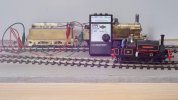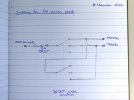Richard Gawler
Western Thunderer

This tender (7mm scale) contains a battery pack, radio receiver and motor controller. The tender is coupled to the loco for other trials, but the output from the motor controller is electrically connected to the track. The motor in the loco coupled to the tender is electrically isolated.
I am using the controller to drive the Minerva Manning Wardle, which it seems to do very well. The controller will drive a Dapol 58xx instead of the MW just as nicely.
It seems to me, I could build a small, self-contained layout running with one loco in steam and powered by this tender. The loco in steam could be the loco attached to the tender (of course) or, with a changeover switch on the tender and some “pickups” on the wheels to put the power onto the track, any analogue loco with a compatible motor. And I get a wireless handset which always seems a pleasant way to control a train.
I wonder, do other people do this?

